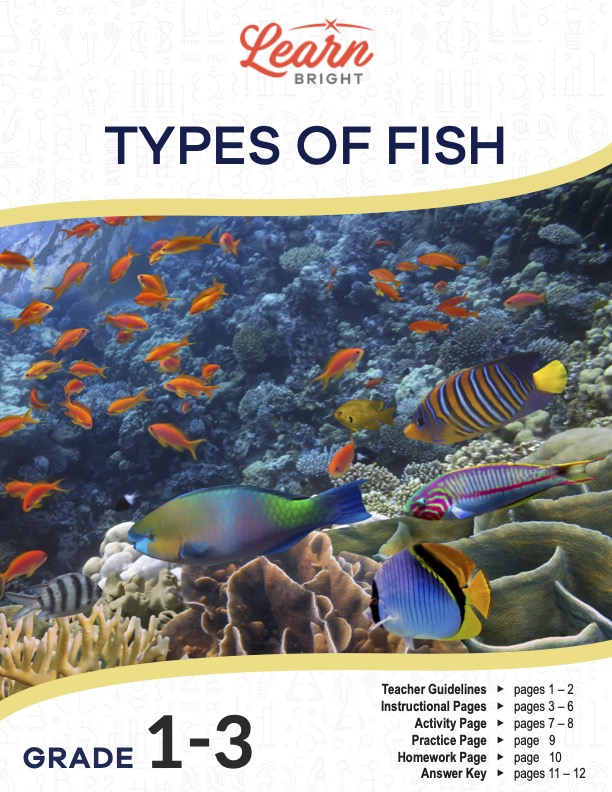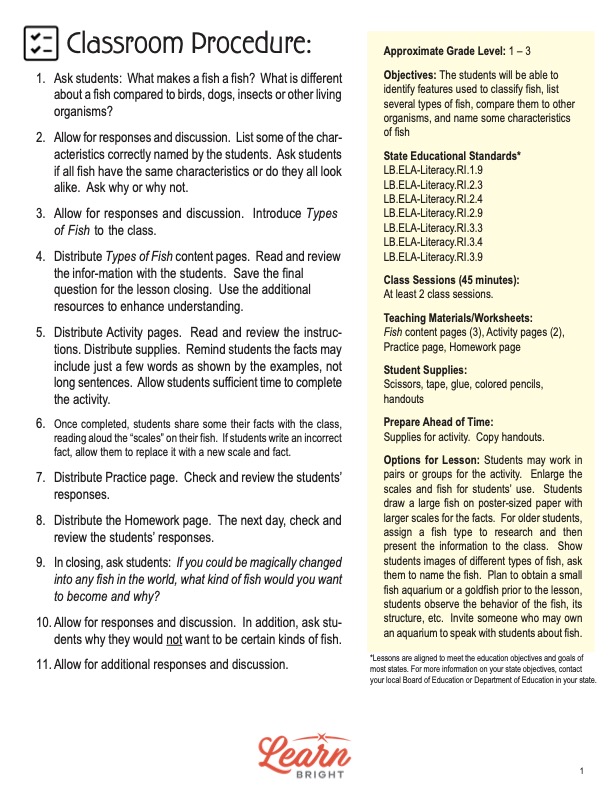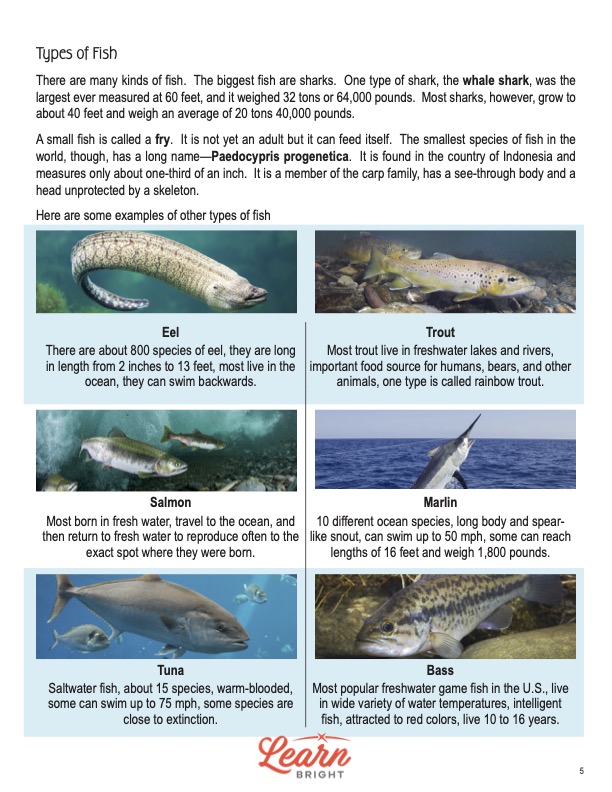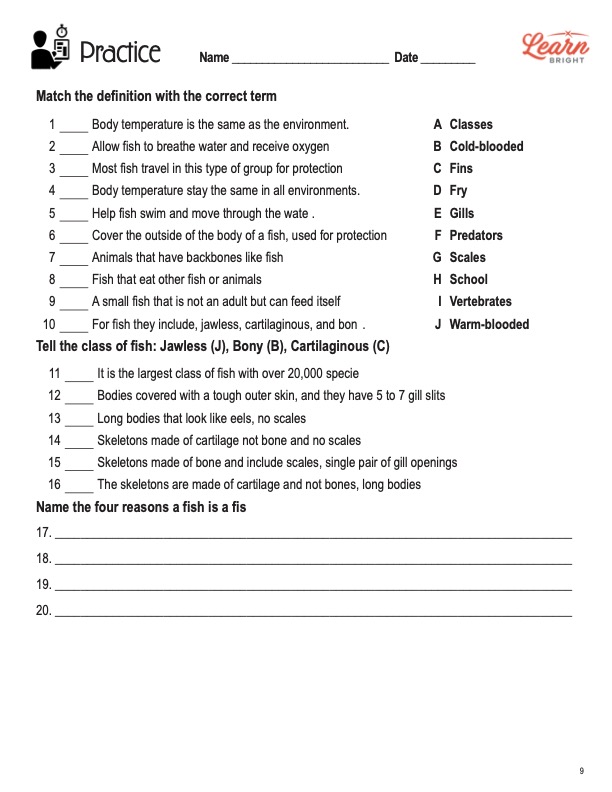Description
What our Types of Fish lesson plan includes
Lesson Objectives and Overview: Types of Fish teaches students how to identify unique features that people use to classify fish. Students will discover several types of fish and compare them to other organisms. They will learn the names of these aquatic creatures and be able to identify and list their traits. The lesson is for students in 1st grade, 2nd grade, and 3rd grade.
Classroom Procedure
Every lesson plan provides you with a classroom procedure page that outlines a step-by-step guide to follow. You do not have to follow the guide exactly. The guide helps you organize the lesson and details when to hand out worksheets. It also lists information in the yellow box that you might find useful. You will find the lesson objectives, state standards, and number of class sessions the lesson should take to complete in this area. In addition, it describes the supplies you will need as well as what and how you need to prepare beforehand. For this lesson, you will only need scissors, tape, glue, and colored pencils.
Options for Lesson
This lesson contains a number of extra ideas or activities in the “Options for Lesson” section that you can incorporate into the lesson if you want to. One idea is to enlarge the scales for the activity or have students draw their own fish on a poster-sized paper. For older students, you can assign them a type of fish to research and later present to the class. Another idea is to gather images of different types of fish and ask students to name them. You could also get a small fish aquarium or a goldfish prior to the lesson. Have students observe them, their behavior, and their structure. A final idea is to invite someone who owns an aquarium to speak with the class.
Teacher Notes
This page is for you to write any additional notes or ideas you have for the lesson. The paragraph on this page provides a little extra information or guidance for the lesson. It also contains some suggestions for the lesson that you can take advantage of if you wish. Use the blank lines to write down your thoughts.
TYPES OF FISH LESSON PLAN CONTENT PAGES
What Is a Fish?
The Types of Fish lesson plan contains four total pages of content. Students will first learn what a fish is and what traits they all have in common. They will learn that all fish live in bodies of water, such as ponds, streams, and tanks. Fish cannot control their body temperature; instead, their temperature is the same as the environment they live in. They have fins and gills to help them swim and breathe, and every one of them is a vertebrate, which means it has a backbone just like a human.
The lesson explains that even though humans and fish both have backbones, humans cannot be fish. They don’t meet all of the requirements, such as living in water and having fins and gills. While all fish live their entire lives in the water, they are not all the same. There are 32,000 different species! They come in many different shapes, sizes, colors, and more. Some can only live in fresh water while others must live in salt water. However, there are just three main classes or types of fish that all the species fall into: jawless, cartilaginous, and bony.
Jawless fish usually have long bodies and look like eels. They also don’t have any scales. Their skeletons are made of cartilage instead of bones. Bony fish, on the other hand, have bone skeletons, scales, and a single pair of gill openings. The majority of fish fall into this category. Finally, cartilaginous fish have cartilage skeletons and no scales. However, unlike the jawless class, these species have a tough outer skin. They also have between five and seven sets of gills.
More Characteristics
It may surprise some students to learn that several animals they may have thought were fish are actually not. Whales and dolphins, for instance, live in the ocean but are actually mammals. Whales are mammals because they breathe air and have lungs rather than gills. Dolphins are also warm-blooded and cannot breathe in water using gills like fish. Other animals that are not fish include the octopus, jellyfish, and starfish.
Students will learn many more traits that fish species have in common. The gills of a fish help them breathe water. While humans use their lungs, fish get their oxygen from the water instead of the air. A fish’s fins help them move through the water quickly and smoothly. Its scales, if it has them, protect their skin from attacks and helps it swim faster through the water. The shape of a fish’s mouth is a clue as to what it can eat. The larger the mouth, the bigger its prey. Its shape also indicates whether or not the fish finds its food at the bottom or top of the body of water in which it lives.
All fish have to eat, but what they eat depends on the fish. Some rely on the plant life under water, such as algae scraped off rocks. Others are predators and eat other fish and animals. Scientists refer to a group of fish that swim together as a school. When they swim together, they are harder to catch, which confuses predators and keeps them safer. Students will also discover that fish have ears, but they aren’t the same as human ears. A fish has an inner ear for balance and hearing. It also helps them detect vibrations in the water. A fish’s sharp sense of smell also helps it detect odors in the water.
Types of Fish
The lesson then describes how many types of fish there are in the world. The biggest fish are sharks. The whale shark is the largest at 60 feet. It weighs 32 tons, which is 64,000 pounds! The smallest fish has a very long name: Paedocypris progenetica. These fish only live in the country of Indonesia and measure at about a third of an inch. It is a member of the carp family, has a see-through body, and has a head without skeletal protection.
Some specific species students will learn about are the eel, trout, salmon, marlin, tuna, and bass. There are roughly 800 species of eel. They measure between 2 inches and 13 feet long. Most eels live in the ocean — and they can swim backward! Trout live in freshwater lakes and rivers. They are one of the most important food sources for bears and other animals, and even humans. Most salmon are born in fresh water, travel to the ocean, and then return to fresh water to reproduce. They often return to the same spot in which they were born.
There are only 10 different ocean species of marlin. They have long bodies and spear-like snouts. They can swim up to 50 miles an hour! Some reach lengths and weights of 16 feet and 1,800 pounds. Tuna are saltwater fish. There are about 15 species of them. They are actually warm-blooded rather than cold-blooded, and they can swim up to 75 miles and hour. Some species are close to extinction. The most popular freshwater game fish in the U.S. is bass. Bass live in a variety of water temperatures and are rather intelligent. Red colors attract them, and they live for as long as 16 years.
TYPES OF FISH LESSON PLAN WORKSHEETS
The Types of Fish lesson plan includes three worksheets. Each one will help students solidify their grasp of the material from the lesson. There are answer keys for the practice and homework worksheets at the end of the document. They present the correct answer in red. If you choose to administer the lesson pages to your students via PDF, you will need to save a new file that omits these pages. Otherwise, you can simply print out the applicable pages and keep these as reference for yourself when grading assignments.
SCALES ACTIVITY WORKSHEET
For the activity, students will write a fact about fish on the scales on the worksheet. Then they will cut out the scales and glue or tape them onto the large picture on the next page. They can color the picture if they want. You can also have them draw their own or find other ways to be creative with it.
MATCH AND REVIEW PRACTICE WORKSHEET
There are a few sections of the practice worksheet. First, students will match 10 terms to the correct definition. The next section contains six statements. Students will decide whether each statement represents the jawless (J), bony (B), or cartilaginous (C) class. Finally, they will write the four reasons a certain animal would be a fish.
TYPES OF FISH HOMEWORK ASSIGNMENT
Students will first review six photos and decide which type of fish each photo represents. They will also include a fact about each fish. Then they will answer 11 questions using what they learned in the lesson. Finally, they will explain why certain animals are not actually fish.










